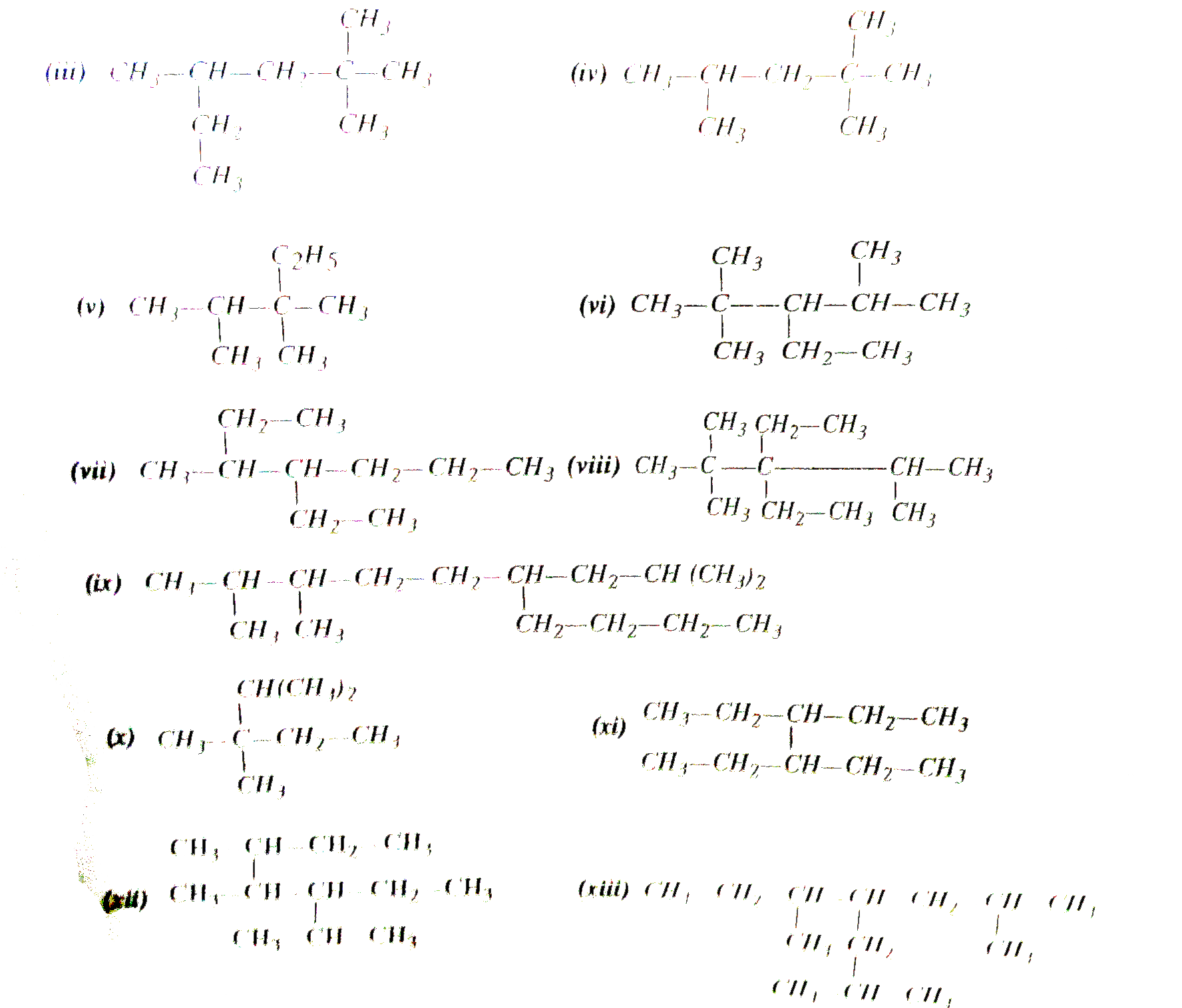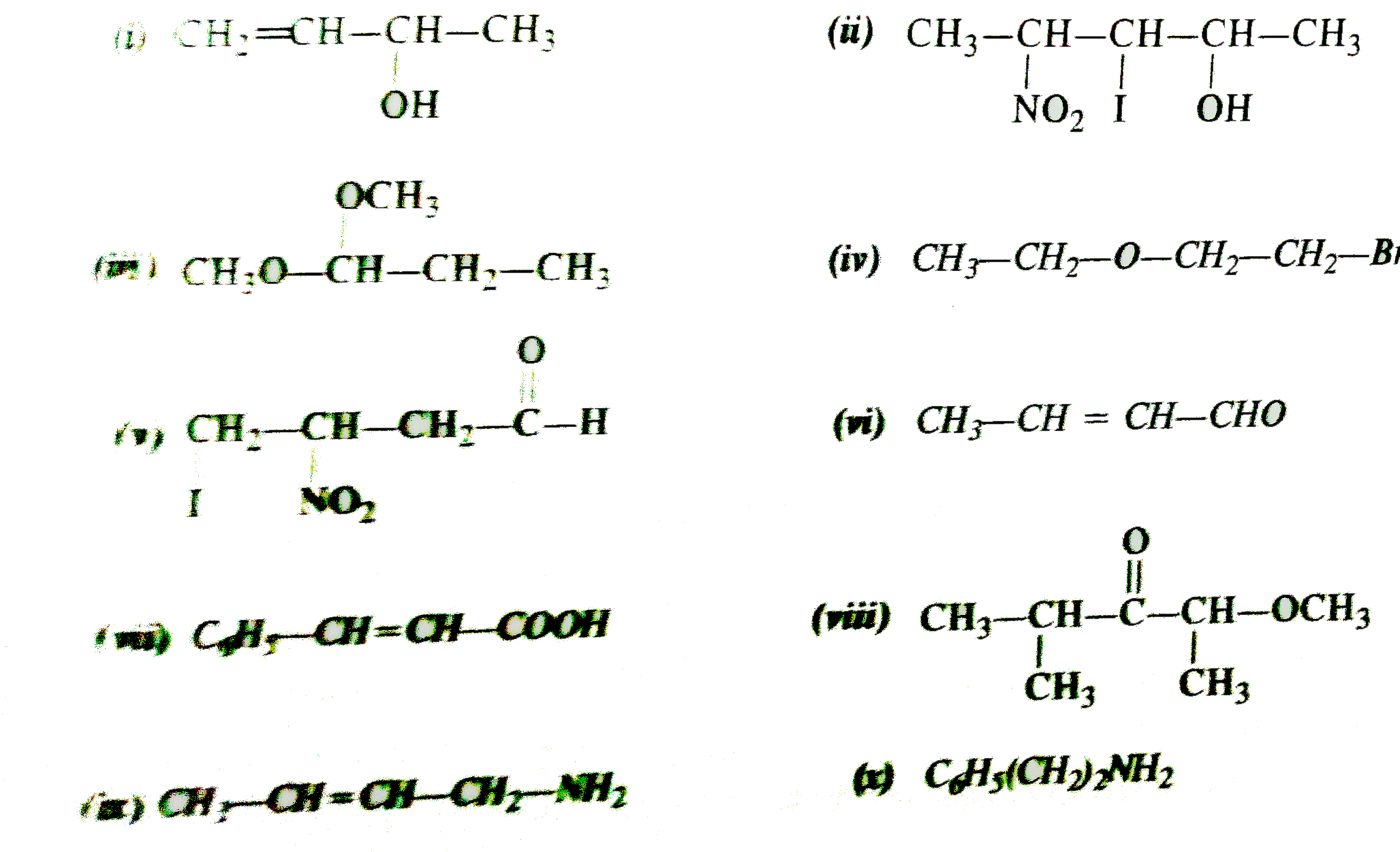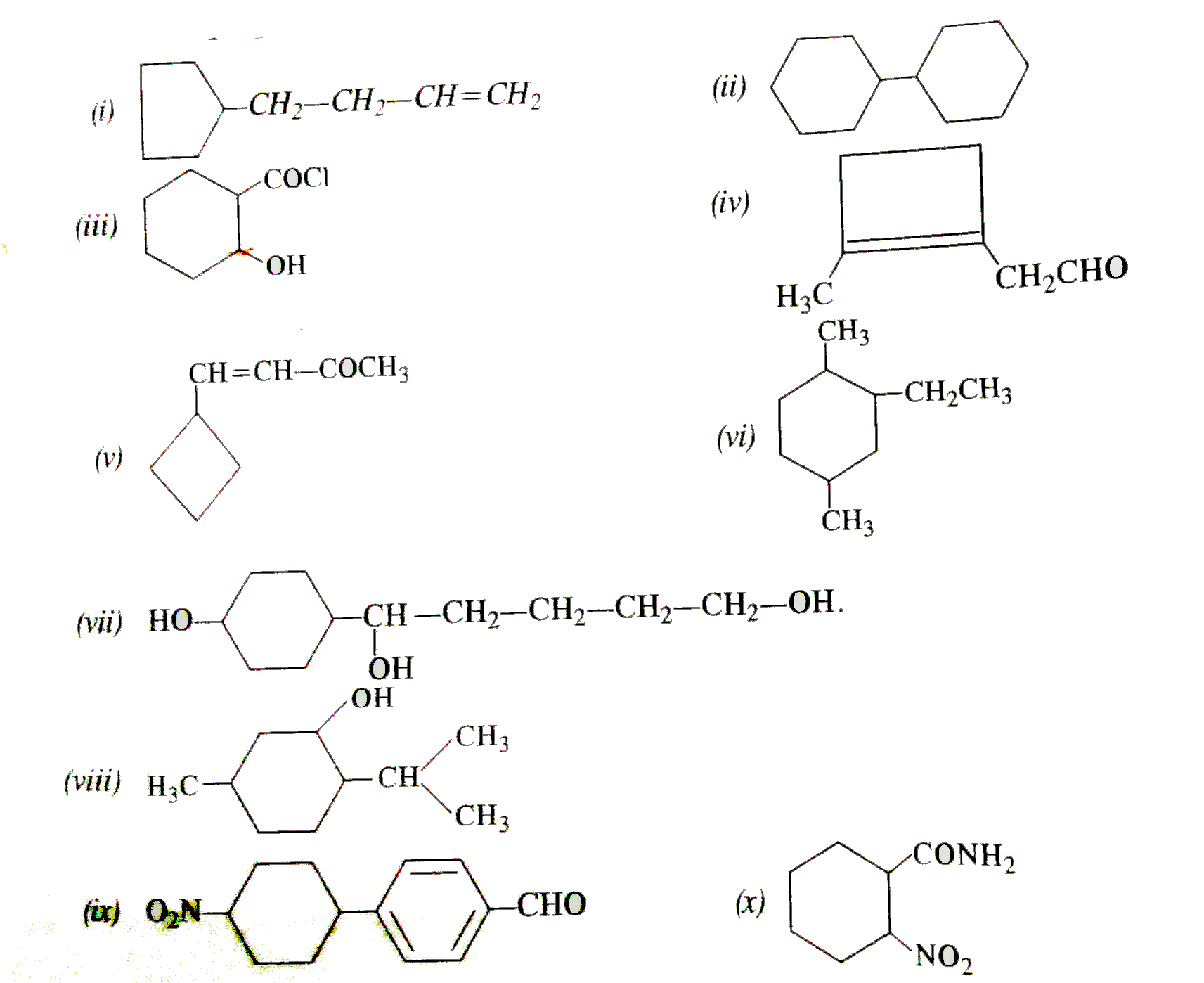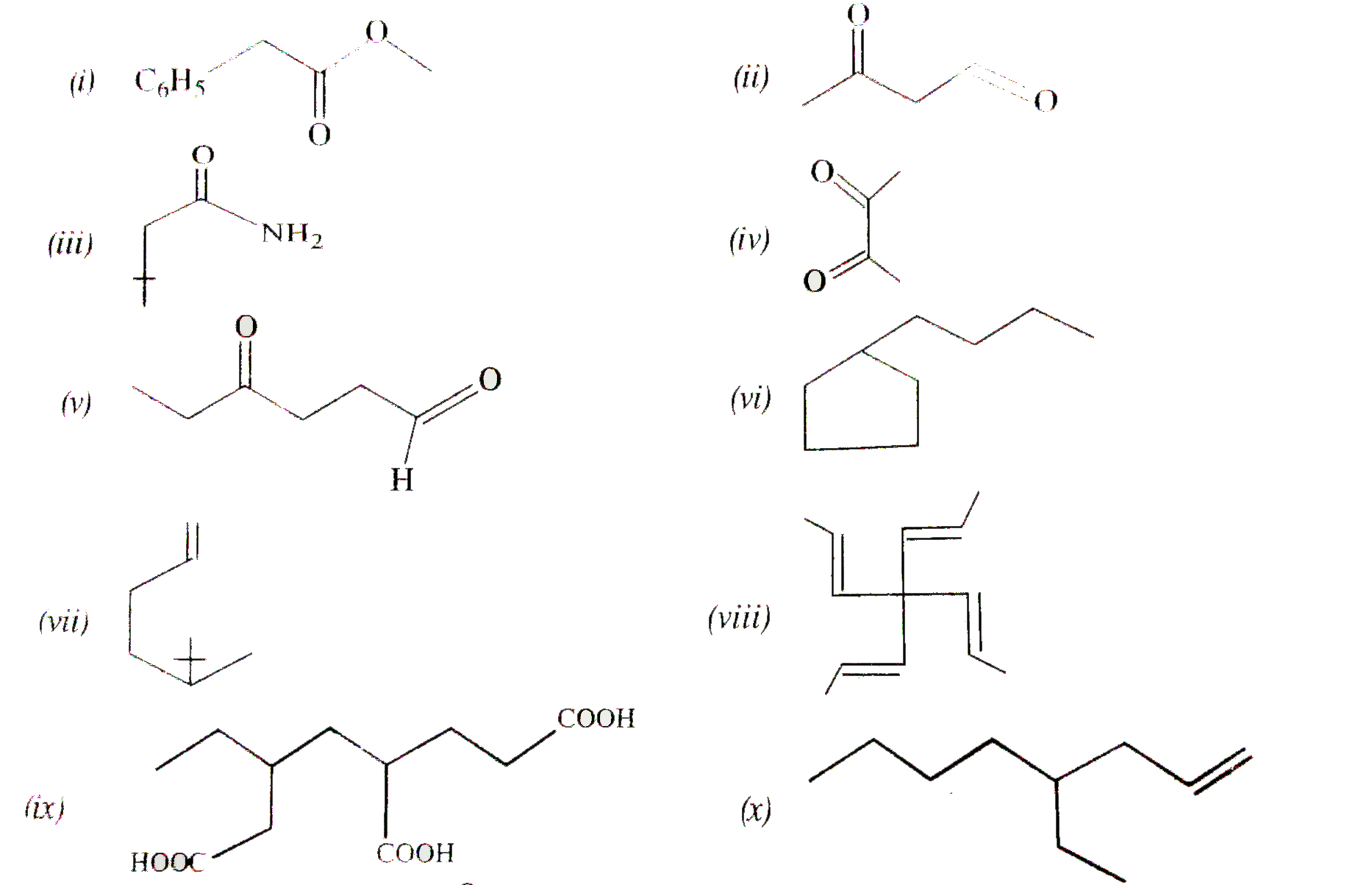Complete Solutions to Example of chapter ORGANIC CHEMISTRY - SOME BASIC PRINCIPLES & TECHNIOUES of Class 11 book with complete answers and questions
| Class 11 | CHEMISTRY |
| Chapter | ORGANIC CHEMISTRY - SOME BASIC PRINCIPLES & TECHNIOUES |
| DINESH COMPANION CHEMISTRY | Example |
| Number Of Questions | 35 |
| Academic Year | 2023-24 |
How many sigma and pi bonds are present in the following molecules :
`(i) CH_(3)-CH_(3)" "(ii) CH_(3)-OH" "(iii) CH_(2)=CH-C equiv N" "(iv) CH_(2)=C=CH_(2)CH_(3)" "(v) CH equiv C CH=CHCH_(3)`03:16View SolutionState the nature of hybridisation of each carbon atom in the following compounds ?
`(a) CH_(3)Cl" "(b) (CH_(3))_(2)C=O" "(c) CH_(3)-C equiv N" "(d) H-overset(O)overset("||")(C)-NH_(2)" "(e) CH_(3)-CH=CH-C equiv N`03:30View SolutionRewire the following formulaes with the help of dash formula and also by bond line notations.
`(i) (CH_(3))_(3)C C_(2)H_(5)" "(ii) CH_(3)overset(O)overset("||")(C)CH_(2)CH(CH_(3))_(2)" "(iii) CH_(3)CH(OH)C_(2)H_(5)" "(iv) (CH_(3))_(3)C CH_(2)CH(CH_(3))_(2)`.05:11View SolutionWrite the IUPAC names of the following compounds
(i) `{:(CH_(3)-CH-CH-CH_(3)),(" | |"),(" "C_(2)H_(5) " C"_(2)H_(5)):}`
(ii) `(CH_(3))_(3)"CC"_(2)H_(5)`
 View Solution
View SolutionWrite the IUPAC names of the following :

 View Solution
View SolutionWrite the IUPAC names of :

 View Solution
View SolutionDraw the structures of the following compounds.
(i) Hex-3-enoic acid, (ii) 2-chloro-2-methylbutan-1-ol
(iii) 5, 5-Diethylnonan-3-ol, (iv) Propane-1, 3-diamine
(v) 4-Nitropent-1-yne, (vi) But-2-ene-1, 4-dioic acid
(vii) 4-Amino-2-ethylpent-2-enal, (viii) Ethyl-3-methoxy-4-nitrobutanoate
(ix) 5-(1-Methylethyl)-3-methyloctane, (x) Hex-4-yn-2-one
(xi) Hepta-1, 4 -dien-3-ol, (xii) 4-Chloropent-2-ene
(xiii) 1-Phenylpropan-2-one, (xiv) 4-Ethyl-2, 6-dimethyldec-4-ene.View SolutionWrite the IUPAC names of the following compounds.
 View Solution
View SolutionGive the IUPAC names of the following :
 View Solution
View SolutionGive the structural formula and IUPAC names of the following compounds.
 View Solution
View SolutionWrite IUPAC names of the following compounds.
 View Solution
View SolutionWhich structural isomerism is exhibited by the following pairs :
(i) `CH_(3)-overset(O)overset("||")(C)-OH` and `H-overset(O)overset("||")(C)-O-CH_(3)`
(ii) `CH_(2) =CHOH` and `CH_(3)-overset(O)overset("||")(C)-H`
(iii) `CH_(3)-CH_(2)-CH=CH_(2)` and `CH_(3)-CH=CH-CH_(3)`
(iv) `CH_(3)-CH_(2)-CH_(2)-NH_(2)` and `CH_(3)-underset(NH_(2))underset("|")(CH)-CH_(3)`06:03View SolutionGive the structures and IUPAC names of all the isomeric monochlorobutane.
06:12View SolutionWrite all the acyclic structural isomers with the molecular formula `C_(4)H_(10)O`. Give their IUPAC names also.
05:40View Solution(a) Which of the following are position isomers ?
`{:((i)" "CH_(2)=CH" "(ii)" "CH_(3)-C-CH_(3)" "(iii)" "CH_(3)-CH=C-CH_(3)),(" |"" ||"" |"),(" "CH_(2)-CH_(3)" "CH_(2)" "CH_(2)):}`
(b) Write the IUPAC name of the functional isomer of `CH_(3)CH_(2)CH_(2)CH_(2)CHO`.
(c) Which type of structural isomerism is shown by the following pair of compounds ?
`{:(" "Br" "CH_(3)),(" |"" |"),(CH_(3)-CH-CHBr_(2) and Br_(2)CH-CH-Br):}`View SolutionUsing curved arrow notation show the formation of reaction intermediates when the following covalent bonds undergo heterolysis.
(i) `H_(3)C-CH_(2)-Cl" "`(ii) `H_(3)C-C equiv N" "`(iii) `CH_(3)ONa`View SolutionIdentify the electrophile centre in the following :
(i) `CH_(3)CHO" "`(ii) `CH_(3)CH=CH_(2)" "`(iii) `CH_(3)COCH_(3)`02:19View SolutionArrange the following resonating structures in order of increasing stability
`underset((I))(CH_(2)=overset(+)(N)=overset(-)(N))" "underset((II))(H_(2)overset(+)(C)=N=overset(-)(N))" "underset((III))(H_(2)overset(-)(C)-overset(+)(N) equiv N)" "underset((IV))(H_(2) overset(-)(C)-N=overset(+)(N))`07:04View SolutionArrange the following carbocations in increasing order of stability and mention basis of the order suggested.
(i) `overset(o+)(C)H_(3)" "`(ii) `CH_(3)overset(o+)(C)H_(2)" "`(iii) `CH_(3)overset(o+)(C)HCH_(3)" "`(iv) `CH_(3)-underset(CH_(3))underset(|)overset(o+)(C)-CH_(3)`05:42View Solutionwhen benzyl chloride is boiled with aqueous `KOH` solution and the solution is acidified by a few drops of dilute `HNO_(3)` followed by `AgNO_(3)` solution, a white precipitate is formed. However, no such precipitate is noticed when the reaction is carried with chlorobenzene. explain.
View Solution0.45 g of an organic compound when analysed by combustion gave 1.10 g carbon dioxide and 0.30 g water. Calculate the persentage of carbon and hydrogen in it.
View Solution0.20 g of an organic compound forms 0.5764 g of `CO_(2)` and 0.1512 g of water on combustion. Calculate the percentage of carbon and hydrogen in the compound.
04:45View SolutionIn Duma's method 0.206 g of an organic compound gave `18.8 cm^(3)` of moist `N_(2)` at `17^(@)C` and 760 mm Hg pressure. If aqueous at `17^(@)C` is 14.5 mm Hg, calculate the percentage of nitrogen in the given organic compound.
View SolutionAn organic compound on analysis gave the following data:
(i). 0.25 gm of the compound on complete combustion gave 0.37 gm of `CO_2` and 0.2 gm of water.
(ii). 0.25 gm of the compound on analysis by Dumas method gave 32 ml of nitrogen gas at STP.
Calculate the percentages of `C,H,N` and `O `in the organic compounds.05:49View SolutionAmmonia produced when 0.75 g of a substance was kjeldahlised neutralised `30 cm^(3)` of 0.25 `NH_(2)SO_(4)`. Calculate the persentage of nitrogen in the compound.
03:07View SolutionIn Kjeldahl's method, 0.4422 g of an organic compound was digested with conc. `H_(2)SO_(4)`. The ammonia evolved on distilling the resulting solution with excess of `NaOH` solution was absorbed in 50 mL of 1 N `H_(2)SO_(4)` solution. The residual acid required 65.5 mL of `N//2` alkali solution for complete neutralisation. Find the percentage of nitrogen in the given organic compound.
View Solution1.216 g of an organic compound was Kjeldahlised and the ammonia evolved was absorbed in 100 mL of 1-N `H_(2)SO_(4)`. The remaining acid solution was made upto 500 mL by dilution with water. 20 mL of this diluted solution required 32 mL of `N//10 NaOH` solution for complete neutralisation. calculate the percentage of nitrogen in the compound.
View Solution0.40 g of an organic compound gave 0.30 g of silver bromide by carius method. Determine the percentage bromine in the compound.
03:07View SolutionIn an estimation od sulphur by carius method, 0.2175 g of a compound gave 0.5825 g of barium sulphate. Calculate the percentage of sulphur in the compound.
View Solution0.515 g of an organic compound containing phosphorus gave 0.214 g of magnesium pyrophosphate in Carius method for the estimation of phosphorus. Calculate the percentage of phosphorus in the given organic compound.
View SolutionIn determination by Victor Meyer method, 0.60 g of a volatile substance expelled 123 mL of air measured over water at `20^(@)C` and 757.4 mm pressure. Find the molecular mass of the substance. Aqueous tension at `20^(@)C` is 17.4 mm.
View Solution0.759 g of silver salt of a dibasic acid was ignited to form 0.463 g of the silver residue. Calculate the molecular mass of the acid.
View Solution0.532 g of the chloroplatinate of a diacid base gave 0.195 g of the platinum residue on ignition. Calaculate the molecular mass of the base.
View Solution0.075 g of a monobasic acid required 10 mL of `N//12 NaOH` solution for complete neutralisation. Calculate the molecular mass of the acid
View Solution7.5 g of an acid are dissolved per litre of the solution. 20 mL of this acid solution required 25 mL of `N//15 NaOH` solution for complete neutralisation. Calculate the equivalent mass of the acid.
View Solution
Example questions and complete solutions for chapter ORGANIC CHEMISTRY - SOME BASIC PRINCIPLES & TECHNIOUES of S DINESH & CO CHEMISTRY (HINGLISH) of Class 11
All Exercises from DINESH COMPANION CHEMISTRY Class 11 CHEMISTRY ORGANIC CHEMISTRY - SOME BASIC PRINCIPLES & TECHNIOUES
- Assertion-Reason
- ASSIGNMENT
- CONCEPT BASED QUESTION
- Detection & Estimation of Organic Compounds
- Example
- Matching Type
- MCQB
- MCQS
- N.C.E.R.T.
- NCERT Exemplar Problems
- Problems For Practice
- PURIFICATION & CHARACTERISATION OF ORGANIC COMPOUNDS
- Purification of Organic Compounds
- SHORT ANSWER TYPE QUESTION
- Some Basic Principles in Organic Chemistry
- VALUE BASED QUESTION
